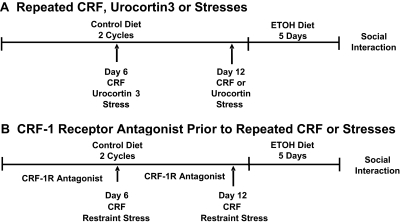Fig. 1.
Protocol for repeated administration of CRF, urocortin 3, or repeated stresses before 5 days of chronic ED to assess for deficits in social interaction: drug treatments. A, at the arrows on days 6 and 12, CRF or urocortin 3 was microinjected weekly into selected brain regions or 60 min of restraint stress was applied followed by 5 days of 4.5% ethanol liquid diet. For these experiments, some groups received control diet for the entire study period and were given either CRF, urocortin 3, or vehicle. A group received vehicle (i.e., no other treatment) before the ethanol diet. Social interaction, a test of anxiety-like behavior, was measured 5 to 6 h after removal of the ethanol diet exposure. B, as a further approach to investigate the role of CRF receptor subtype involved in the repeated CRF or stress-induced sensitization of ethanol withdrawal anxiety-like behavior, a CRF-1 receptor (CRF-1R) antagonist was administered intraperitoneally 15 min before the microinjection of CRF or was microinjected into each of the CRF-positive sites 15 min before the application of restraint stress on days 6 and 12. As noted for A, some groups of rats received only control diet that had vehicle microinjected or vehicle applied before stress. Likewise, a group that received only 5 days of ethanol diet received vehicle. Social interaction test was conducted 5 to 6 h after removal of the ethanol diet exposures.

